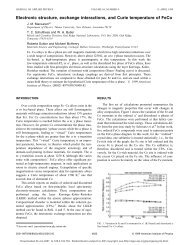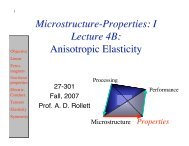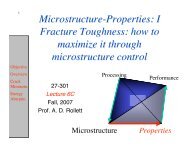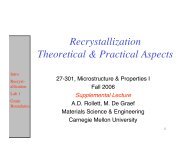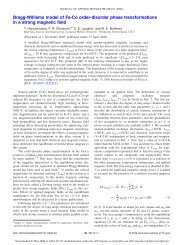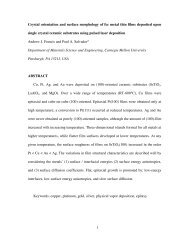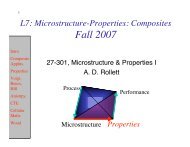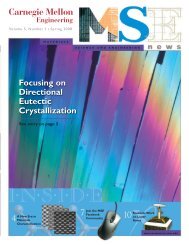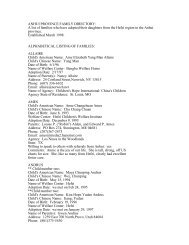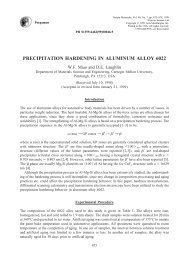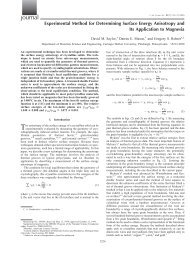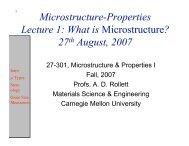Precipitation In Al-Mg-Si Alloys with Cu - Materials Science and ...
Precipitation In Al-Mg-Si Alloys with Cu - Materials Science and ...
Precipitation In Al-Mg-Si Alloys with Cu - Materials Science and ...
Create successful ePaper yourself
Turn your PDF publications into a flip-book with our unique Google optimized e-Paper software.
one of which noticeably modifies the precipitation processes. <strong>Al</strong>so added in Table 1 are crystal<br />
structure <strong>and</strong> lattice parameter information for the different phases according to the sequence in<br />
which they occur under the specific columns. Some of the phases shown <strong>with</strong>in parentheses were<br />
added for completeness, but were not specifically mentioned in the quoted works.<br />
Table 1. <strong>Precipitation</strong> Sequence <strong>and</strong> Precipitate Structure for Different 6xxx <strong>Al</strong>loy Compositions<br />
Composition Peak Age OA 1 OA 2 OA 3 Equilibrium Ref.<br />
Ternary, Excess <strong>Si</strong> β ” + β ”<br />
d<br />
Ternary, Excess-<strong>Si</strong> (low) β<br />
M β<br />
7<br />
” β ’ Ternary, Excess-<strong>Si</strong> (high) β<br />
+ Type B Type C β + <strong>Si</strong> 5, 6<br />
” β ’ + Type A Type A <strong>Si</strong> + β 5, 6<br />
Ternary, Balanced β ” β ’ + β ” β ’ β ’ Balanced + low <strong>Cu</strong> β<br />
β<br />
1, 2<br />
” + L L + β ’ + β ” L + β ’ β ’ Balanced + high <strong>Cu</strong> β<br />
+ L β + λ (Q) + (θ) 7<br />
” + L L + β ” L λ (Q) + β + (θ) 7<br />
Excess <strong>Si</strong> + low <strong>Cu</strong> β ” β ” β ” Q ’ Excess <strong>Si</strong> + high <strong>Cu</strong> β<br />
(<strong>Si</strong>) + Q + (θ) 9<br />
” + Q ’ β ” + Q ’ β ” + Q ’ Q + (β) + (θ) 9<br />
<strong>Al</strong>-<strong>Mg</strong>-<strong>Si</strong>-<strong>Cu</strong> β ” + QP QC+QP+β ’ Q ’ Q+(<strong>Si</strong> or β)+(θ) 12, 13<br />
---------------------------------------------------------------------------------------------------------------------------------------------------------------------------------------<br />
β ” β ’ β<br />
Monoclinic Hexagonal <strong>Cu</strong>bic<br />
a=0.65nm, b=0.76nm (a=0.705, c=0.405)nm a=0.642 nm<br />
c=0.405nm, γ=70°<br />
L Q ’ Q, λ<br />
----- Hexagonal Hexagonal<br />
(a=0.8, c=0.7)nm (a=1.03, c=0.405)nm (a=1.04, c=0.405)nm<br />
λ d ” M<br />
--------- (a=1.03, c=0.405)nm<br />
QP QC B ’<br />
Hexagonal Hexagonal Hexagonal<br />
(a=0.393, c=0.405)nm (a=0.67, c=0.405)nm (a=1.03, c=0.405)nm<br />
Type B Type C<br />
Hexagonal Hexagonal<br />
(a=0.67, c=0.405)nm (a=1.04, c=0.401)nm<br />
Type A<br />
Hexagonal<br />
(a=0.405, c=0.67)nm<br />
A representative of the ternary alloy precipitation is the “Ternary Balanced” case. Here the<br />
precipitates are the needle shaped β” phase <strong>with</strong> a monoclinic structure at peak age, a mixture of<br />
β” <strong>and</strong> hexagonal β’ progressively approaching β’ <strong>with</strong> overaging, <strong>and</strong> the equilibrium cubic β<br />
phase (<strong>Mg</strong>2<strong>Si</strong>) [1,2]. The “Excess-<strong>Si</strong> + low <strong>Cu</strong>” case represents the quaternary alloy [9]. Here the<br />
precipitate at peak age is still cited as β”, while a new phase originally designated as B’ by Dumolt<br />
et al. [4], which is identical to the hexagonal Q’ phase, precursor to Q, appears at over age <strong>and</strong><br />
leads to the equilibrium Q phase. (To clear some confusion, Dumolt et al. studied the commercial<br />
6061 alloy that contains 0.18-0.3% <strong>Cu</strong> - hence a quaternary alloy - <strong>and</strong> the B’ phase for which they<br />
provided detailed precipitate structure referred to the metastable precursor phase of Q, which is<br />
better termed Q’ [10].) For “Excess-<strong>Si</strong> + high <strong>Cu</strong>” alloy, Q’ occurred together <strong>with</strong> β” at peak age<br />
[9]. For the “Balanced + low <strong>Cu</strong>” alloy (0.65<strong>Si</strong>, 1<strong>Mg</strong>, 0.25<strong>Cu</strong>), a new lath-shaped phase L is cited<br />
to occur at peak age along <strong>with</strong> β”, for which only the lattice parameter but no crystal structure<br />
data are available [7]. Apparently the L phase is different from Q’ <strong>and</strong> occurs as a precursor to Q’<br />
<strong>and</strong> is present at peak age through over age, while Q’ more often occurs at over age. The same L<br />
phase also occurs in “Balanced + high <strong>Cu</strong>” alloy (0.65<strong>Si</strong>, 0.87<strong>Mg</strong>, 1<strong>Cu</strong>), but as the <strong>Cu</strong> additions



